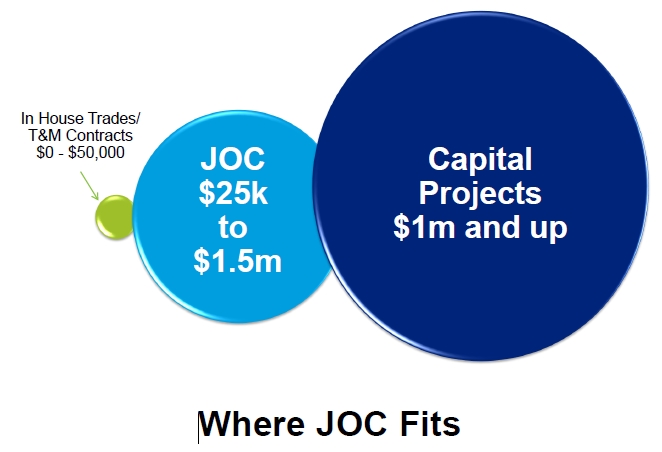Early 1980’s – U.S. Military Academy, West Point, facility engineers realized the disadvantages of the design-bid-build construction delivery system, and implemented an a new indefinite delivery- indefinite quantity (IDIQ) facility maintenance contract which was first used by the Supreme Headquarters Allied Powers Europe (SHAPE) in Belgium.
West Point managed to accomplish the following:
- Minimized the response time for facility construction.
- Reduced the workload on in-house design staff.
- Enhanced quality control.
- Lowered the contract administration costs.
- Reduced construction costs.
- Reduced the backlog of maintenance and repair.
[1999, Journal of Construction Education, Development of the Job Order Contracting (JOC) Process for the 21st Century, Dean T. Kashiwagi and Ziad Al Sharmani, Arizona State University, Tempe, Arizona]
Timeline (please comment/suggest additions and/or modifications)
1981 -“ Existing in federal procurement since 1981, and only recently making its way down to state and municipal levels, Indefinite Delivery (ID) contracting is a procurement mechanism designed to streamline the competitive bidding process for governmental owners. Invented by the Department of Defense for use by the North Atlantic Treaty Organization, ID contracts have been used routinely and effectively by the DOD for installation maintenance, minor repair, and construction projects since its inception in 1981.” “Whether classified as an ID, JOC, or TOC contract, each shares certain similarities.” (2006, IDIQ Contracts, Denise Farris | March 30, 2006 | Construction)
1985 – West Point Academy
1986 – Air Force bases – SABER
1987 – Navy JOC
1988 – JOC Implemented Army-wide (1997 – Improving the Army’s Job Order Contracting ProgramCE704R1, September 1997, Jordan W. Cassell, Linda T. Gilday)
1988 – When job order contracting was first developed in 1988, MCACES was the only estimating system available to JOC users. Since that time, the JOC concept has changed somewhat; contracting officers now have a choice of estimating systems. Current Army policy requires that all Army installations use the MCACES UPB as the estimating system under JOC. The Air Force uses the R.S. Means estimating system. The Navy uses both the R.S. Means and the MCACES UPB estimating systems. (Improving the Army’s Job Order Contracting Program CE704R1 September 1997)
1990 – U.S. Navy publishes Job Order Contracting P068B, September 1990
1992 – Assistant Secretary of the Army for Installations, Logistics, and Environment, and the Assistant Secretary of the Army for Research, Development, and Acquisition establish a Job Order Contracting Steering Committee to develop recommendations for policies, guidance, procedures, and training for the U.S . Army JOC Program
1995 – Army’s JOC policy manual, Job Order Contracting Guide, is published.
1996 – U.S. Army’s Center for Public Works (USACPW) Humphreys Engineer Center published the Job Order Contracting Directory (October 1996), and supports a telephone hotline for JOC installations through a private contractor, U.S. Cost, Inc., and publishes a newsletter called “JOCkey”.




